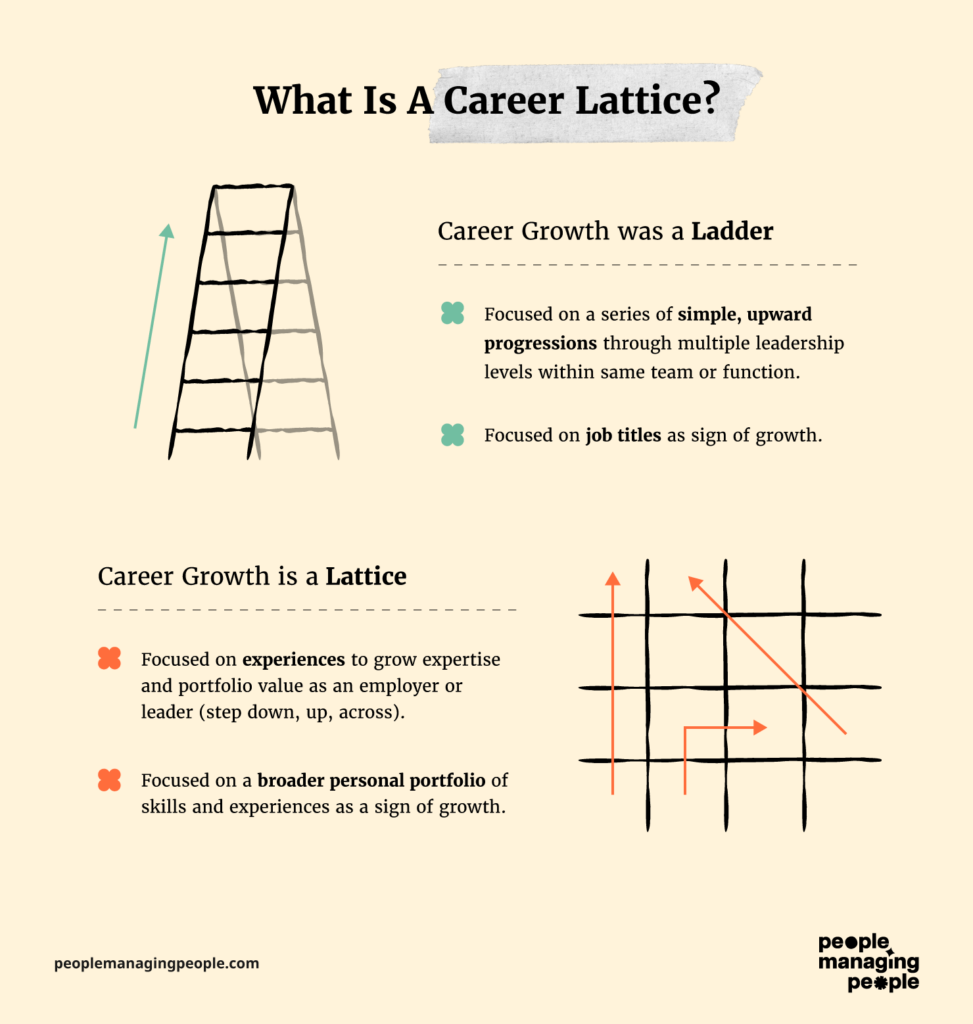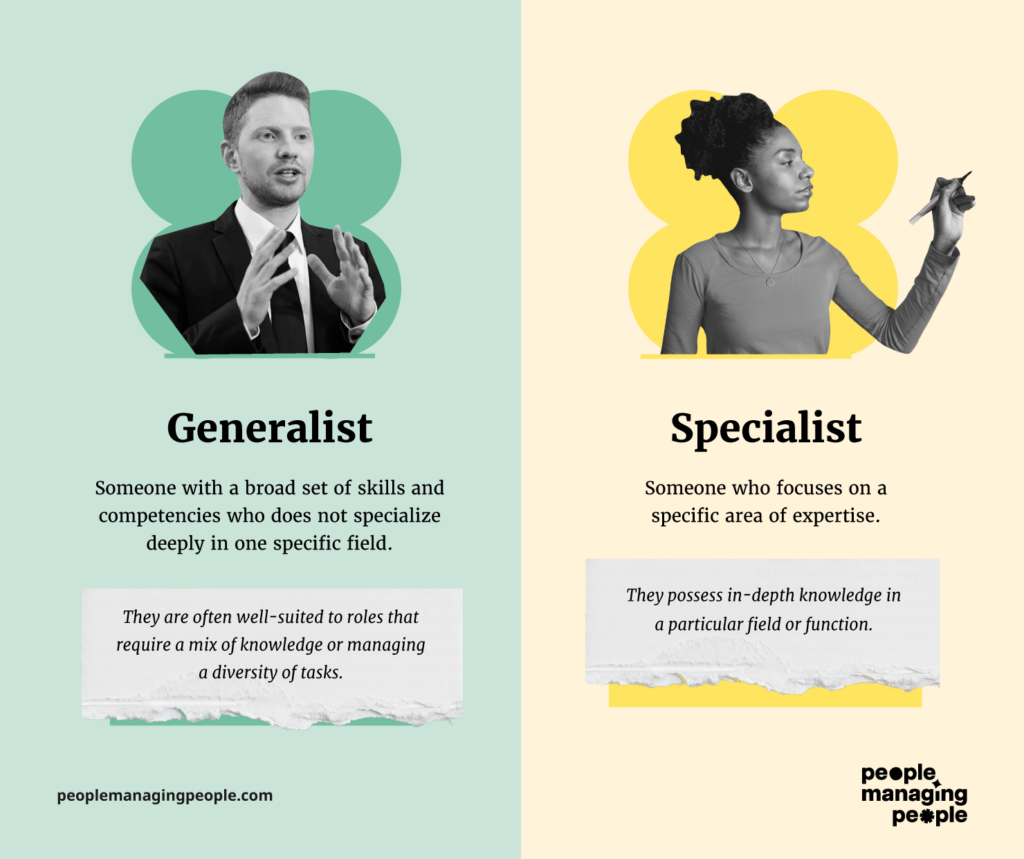Traditionally, career growth has been described as a ladder representing a series of upward progressions with job titles as markers of growth and success.
However, the ladder model no longer suits the reality of today’s workplaces where organizational hierarchies shift regularly, technology and digital transformation are reshaping industries, organizations are dealing with more market volatility than ever, and employees are seeking more development opportunities.
Instead, the career lattice is a more dynamic approach representing a multi-directional career path better suited to the modern workforce.
What Is A Career Lattice?
The career lattice is a flexible model that supports lateral, diagonal, upward, and downward movement as a part of career progression. As opposed to the rigid trajectory of the corporate ladder, the lattice allows for multiple growth opportunities and potential career paths.
Employees are freer to follow their interests and areas of strength as opposed to being stuck with only one way to progress.
Rather than climbing the corporate ranks, there’s a greater focus on experiences and a broader personal portfolio of skills and experiences as signs of growth.

Benefits Of The Career Lattice Approach
For organizations and employees, the main benefits of the career lattice approach are:
- Enhanced skill development: People are encouraged and supported to acquire diverse skills and experiences, making them more versatile and adaptable.
- Succession planning and talent management: By developing people to have broader skill sets, organizations expand the internal talent pool for open roles.
- Adaptability to industry changes: As industries evolve, companies can leverage internal talent rather than needing to continually hire externally.
- Increased employee engagement and satisfaction: Flexible career paths show that the company values employees' growth goals, boosting morale and job satisfaction.
- Improved retention rates: With more diverse internal career growth options open to employees, turnover will likely decrease.
- Career flexibility for employees: A skills and competency-based approach accommodates employees’ different life stages and personal circumstances while simultaneously meeting organizational talent needs.
Career Lattice Example: Spotify
Spotify is an example of a company that has embraced the career lattice approach, grounded in intentional employee development.
The company has moved away from the hierarchical model of mobility, providing access to tools and training to all employees, regardless of their level in the organization.
As Johanna Bolin Tingvall, Global Head of L&D, Talent Growth, and Community Experience said on the HR Over the Counter podcast, “Career is all about growth. This does not mean a linear career. Career is all about developing where you want to develop.”
By explicitly expecting and empowering their employees to drive their own growth, with the purposeful support and guidance of their manager, Spotify created a culture of continual learning that constantly feeds their internal talent pool.
Challenges Of Adopting A Career Lattice Approach
While there are significant benefits to shifting to a career lattice approach, it’s not without challenges.
This is both a process and behavior change initiative that requires executive sponsorship and dedicated resources to create the processes, practices, tools, and training necessary.
| Mindsets | Traditionally, career success was tied directly to job title. People who have internalized these beliefs may have a tough time shifting their mindset. |
| Assessment Methods | Companies have to establish effective, consistent methods for both leader assessment and self-assessment grounded in skills and competencies. |
| Leader Training | Leaders need training to effectively support employees as they pursue a multi-directional career path. This includes guidance on assessing skills and competencies, providing feedback, matching skill sets to opportunities, and creating development plans. |
| Career Pathing Resources | Creating a toolkit of on-demand resources will help both leaders and employees. This can include things as simple as a PDF career roadmap or career conversation templates to more robust resources like investing in interactive career mapping technology. |
| Visibility | People benefit from exposure to examples of diverse career paths. Having leaders share their journeys in Town Halls or featuring stories on the employee portal can help. At the same time, people should be able to easily review open roles with clear, skills-based job descriptions. |
How To Shift To A Career Lattice Approach
If your organization is anchored in a traditional model, transitioning to the career lattice approach will be a significant shift.
It will require creating new frameworks and resources, changing expectations, providing training and tools, and, most importantly, changing people’s behaviors and mindsets.
Step one: Create skills and competency maps for both roles and employees.
Skills and competencies are slightly different. Skills are the singular abilities (often tactical or technical) required to successfully perform a task.
Competencies, on the other hand, are a combination of knowledge, skills, and traits (sometimes referred to as “soft skills”) necessary to perform in a role.
In the career lattice, it’s important to understand the transferable skills and competencies that someone can take from one job to another, perhaps less obvious, next role. There are two steps to achieve this:
- Create maps for each role to identify the skills, knowledge, and abilities needed to perform it competently.
- Create a map to analyze each employee’s skills and competencies to understand their abilities.
As part of the process, it’s important to distinguish between employees with generalist and specialist skill sets.
Both are valuable for different reasons. This is a critical input when thinking about potential next steps.

Step two–Promote internal mobility by training leaders to assess skills and competencies
Internal mobility can involve everything from promotions, lateral moves, job rotations, stretch assignments, stepping back to a more junior position, or moving departments/teams/functions/locations.
To enable true mobility, leaders need to know how to properly assess their employees. To help them achieve this:
- Define competencies and skills. Having clear, shared definitions for each sets the foundation.
- Train leaders to objectively identify people’s abilities using a combination of observation, probing questions, evaluation of performance/results, and gathering feedback.
- Include skills and competency assessments in performance reviews and link the assessments to performance goals.
- Promote a growth mindset—the belief that people can continue to develop their abilities; failure is part of learning; and that effort is the path to mastery.
- Write job descriptions that outline both skills and competencies, highlighting transferable skills.
Step three–Provide training opportunities and create career pathing resources
When building your learning strategy, incorporate a variety of flexible offerings and methods so that people can create individualized learning paths to support their career growth. This includes:
- Training to develop key skills and competencies needed in the organization.
- Coaching to support people in achieving their goals.
- Mentorship programs to provide a direct knowledge transfer from experienced leaders to less experienced people.
- Job shadowing to provide a firsthand, immersive experience of specific roles.
- On-demand resources like e-learning, articles, and podcasts.
- Town Halls or other venues for people to learn about the business from leaders.
At the same time, enable employees to proactively career plan with resources they can use with leaders including:
- Career maps to create a personalized roadmap capturing career goals, skills and competencies (currently have and need), potential learning opportunities, networks, mentors, and key next steps
- Individual development plans (IDP) to identify growth opportunities and map out the skills and competencies an employee will work on, the ways that they will get that training/education, and the timeline and milestones for completion.
- Career/development conversation templates for both leaders and employees to use as guides to talk about career growth and development on an ongoing basis.
- A speaker series for leaders to share their career paths to inspire others, help them see what’s possible, and how people can chart their own course.
- Feedback and assessment tools like stakeholder feedback guides, self-assessments aligned to organizational competencies, or tools to request feedback throughout the year from peers, cross-functional partners, direct reports, and leaders.
Step four–Communicate opportunities
Finally, people need visibility of the opportunities available.
While practices like talent reviews and succession planning can help to identify bench talent, the lattice model is partly dependent on people being able to proactively explore and prepare for opportunities when they’re available.
- Transparent job postings via the internal portal or intranet. Make sure that the job descriptions include and highlight the desired transferable skills and competencies.
- Regular internal newsletters highlighting job openings.
- Allow hiring managers to talk about job openings during town halls or other broad company meetings. Focus on roles that lend themselves well to people with transferable skills and competencies.
- Lunch-and-learn or internal job fairs where people can talk to hiring managers about current open roles.
- Create a talent marketplace where leaders can post requests for additional support on projects so that employees can raise their hands for stretch assignments.
Tips for Employees Taking A Lattice Approach
If you’re thinking about your career progress as a lattice rather than a ladder, here are some things that you can do whether or not your organization is set up to support this approach.
- Focus on a type of role, not a specific job title. By fixating on a title, you may narrow your options and miss out on exploring roles that will help you build your skills and grow your career.
- Identify your transferable skills. You can apply transferable skills (problem-solving, critical thinking, ability to flex your communication to different audiences) in multiple roles.
- Build your connections. Ask for help in connecting with others both inside and outside of your organization. If someone has a skill you want to learn or a career path you admire, see if your boss, colleague, or friend can facilitate an introduction.
- Share your aspirations. Meet with your boss, HR partner, peers, mentors, and sponsors to have open, honest conversations about what you want to work on, the skills that you are developing, and your desired next steps.
Career Lattice Is A Better Model For Modern Organizations
My career journey is a good example of a career lattice. While I progressively took on more senior roles along the way, I also took steps backward or sideways and shifted into roles in different functions.
Not everyone’s interested in moving into management but see it as the only way to progress. This isn’t good for anyone in the long run.
With technologies available such as internal talent marketplaces and learning management systems, adopting a career lattice has never been easier.
Key takeaways:
- Organizations can benefit from a more iterative and collaborative approach to career pathing to keep pace with the needs of both the business and employees.
- Focusing on skills is the unlock for increasing your internal talent pool and increasing both employee tenure and satisfaction.
- Moving to a career lattice is a cultural change requiring both a shift in mindset and ongoing investment in development resources for employees at all levels.
Join The People Managing People Community
For further advice on talent development, join our supportive community of HR and business leaders sharing knowledge and expertise to help you progress in your career and make greater impact in your organization.


